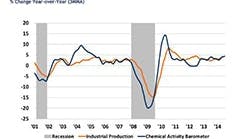The CAB posted a .04 percent increase over June.
The Chemical Activity Barometer (CAB), a leading economic indicator created by the American Chemistry Council (ACC) posted a 0.4 percent increase over June, as measured on a three-month moving average (3MMA). The pace of growth was consistent with earlier growth logged in the second quarter. Year over year growth now stands at a 4.4 percent increase. Uncertainty in global energy markets kept the non-adjusted barometer at a slow 0.1 percent gain in June, but provisional data suggest there is room for further expansion in coming months.The Chemical Activity Barometer has four primary components, each consisting of a variety of indicators: 1) production; 2) equity prices; 3) product prices; and 4) inventories and other indicators.
During July, production-related indicators were up, as were product/selling prices and inventories. After rebounding sharply in May, chemical equity prices have weakened in response to the growing unrest in the Middle East and Ukraine.
Unlike earlier readings, trends in construction-related chemistries suggest a lackluster market for this sector, which includes plastic resins as well as adhesives and sealants, construction chemicals, paint additives and other performance chemistries. Pigments are faring better, as are plastic resins used in consumer product applications. Continued strength in electronic chemicals is encouraging, as the semiconductor industry's early place in the supply chain makes it a bellwether of the industrial cycle. Gains in oilfield chemicals suggest that the boom in unconventional oil and gas will continue to progress, contributing to the overall growth of the U.S. economy.
For more information, visit: www.americanchemistry.com

